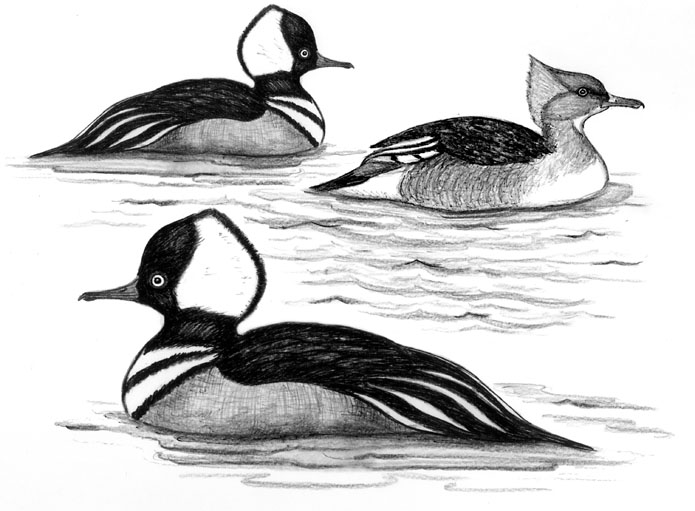
Dear Bird Folks,
When is the breeding season for ducks? Yesterday I watched a flock of male Hooded Mergansers pursuing a lone female. It’s not even winter yet, but these birds were acting like it was spring. Could they be courting or were they just playing?
– Erin, Brewster, MA
They weren’t playing, Erin,
I know swimming sounds like fun to us, but ducks spend most of their lives swimming and the novelty of being in the water has long worn off. Besides, there is nothing fun about floating around in a pond all day, especially this time of year. The days are short, the nights are long, and the water is cold and choppy. It’s a pretty miserable life. I mean have you ever seen a smiling duck? No, of course not. It’s tough being a duck, which explains why they’re always in such fowl moods.
Hooded Mergansers may not have a lot of fun, but what they lack in fun-ability they make up for with good looks. Hooded Mergansers are one our most beautiful ducks. I know a lot of folks would argue that Wood Ducks are the most beautiful, but they are a bit too over the top for me. They can’t seem to decide which colors they look best in, so instead they try to incorporate every color they can think of: green, purple, red, blue, yellow, orange and the list goes on. Wood Ducks look like flying packs of Fruit Stripe gum. I vote for Hooded Mergansers.
The male Hooded Merganser is a fairly small duck with a black back, chestnut sides, a startling white breast, bright yellow eyes and its signature hood. And we aren’t talking about one of those drab hoods like Bill Belichick wears. This hood is bright white, framed in black and can be flashed any time the bird wants to be noticed. The hood can also be lowered whenever the bird has a headache or just wants to be left alone. Mergansers have very thin, non-duck-like bills and are excellent divers. Their eyes have the odd ability to change their refractive properties while submerged, which gives them superb underwater vision. In fact, many young mergansers earn extra cash by taunting tourists to “huck a shining coin” in the water. The birds then fetch the coins and use them to buy root beer and Fruit Stripe gum.
Most waterfowl have rather expansive ranges. Mallards, for example, breed throughout most the world. But Hooded Mergansers only live in North America. They like it here, so why leave? They’d only have to learn another language. Nesting mergansers are found in various locations in Massachusetts, but they are only seen on Cape Cod during the cooler months. The birds arrive here in late September and have pretty much cleared out by the end of April. Just don’t expect to see a lot of them, even in the winter. They aren’t very common or gregarious birds.
I read a story in a newspaper last week that quoted some bonehead who said that ducks love each other’s company. While most ducks do like each other’s company, this is not the case with Hooded Mergansers. They tend to stay in fairly small flocks and are inclined to keep to themselves. There’s a small pond in Eastham (MA) that often has hundreds of assorted ducks splashing around in it this time of year. Right next to this small pond is an even smaller pond, but the only ducks I ever see on this smaller pond are a few Hooded Mergansers, which quietly keep to themselves. (BTW, in case you are wondering, the bonehead the newspaper quoted was me.)
Hooded Mergansers may not be big party birds, but that doesn’t mean they don’t like a little action. Most songbirds don’t bother looking for a mate until spring and even other ducks don’t form pairs until early winter. Hooded Mergansers can’t wait that long. They want to pick their mates ASAP. By mid-November many mergansers have started their courting displays. Typically, a small number of males surround a single female and start strutting their stuff. There’s lots of crest raising, head bobbing and even some ritualistic drinking. Yes, drinking, something these birds have in common with human courtship.
By late April, Erin, the mergansers have left Cape Cod for their breeding grounds. The duller female hoodies lay their eggs in old tree cavities. After the eggs have been laid (usually about ten), the female begins incubating. At this point her husband moves on. Courting and mating are fine with him, but he draws the line when at dealing with kids…especially ten of them. His work is done until the coming fall, when once again he’ll be strutting his stuff on the local ponds. Hmm. Maybe he doesn’t have such a bad life after all.
On a different topic:
There are two quiet months at bird feeders. One is June, when adult birds are busy feeding insects to their nestlings; the other month is now, December. Why? It’s because the grackles have left, the Blue Jays have stopped hoarding seeds, the weather is mild and natural food is still readily available. Anyone who isn’t seeing many feeder birds should be patient. The birds will be back as soon as the weather turns ugly. In the meantime, make sure the food in your feeders stays clean and dry. But most importantly, don’t call me to complain. There’s nothing I can do. Believe me, I wish I could help. No one feels your pain more than I do. When birds aren’t eating, I don’t have any business and I become like a duck. You know, in a fowl mood.